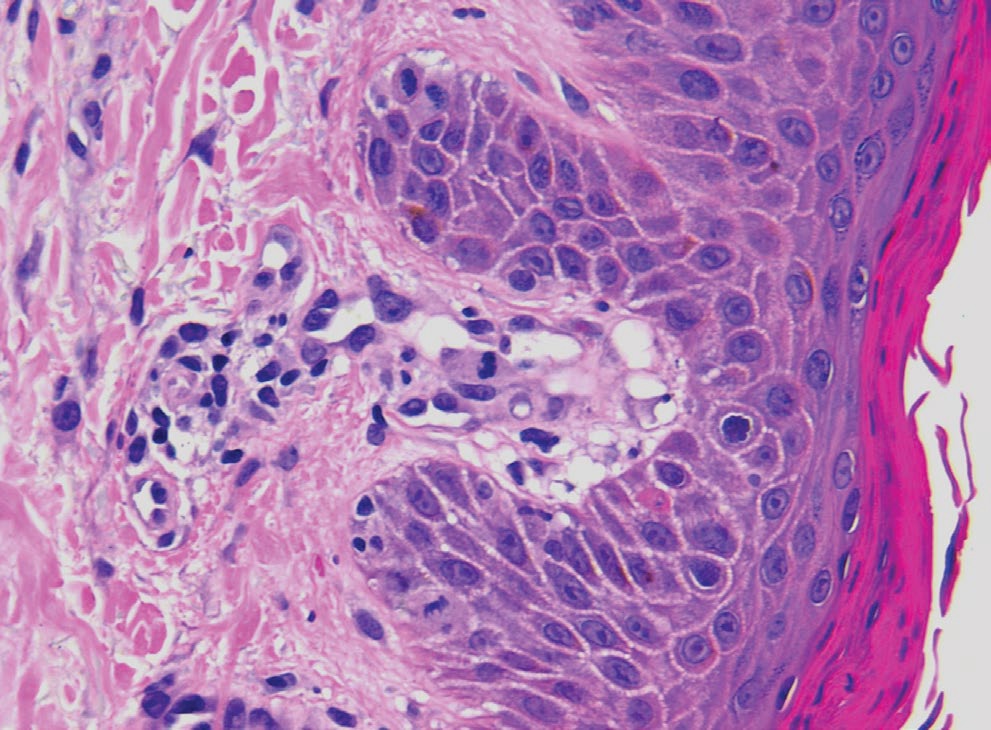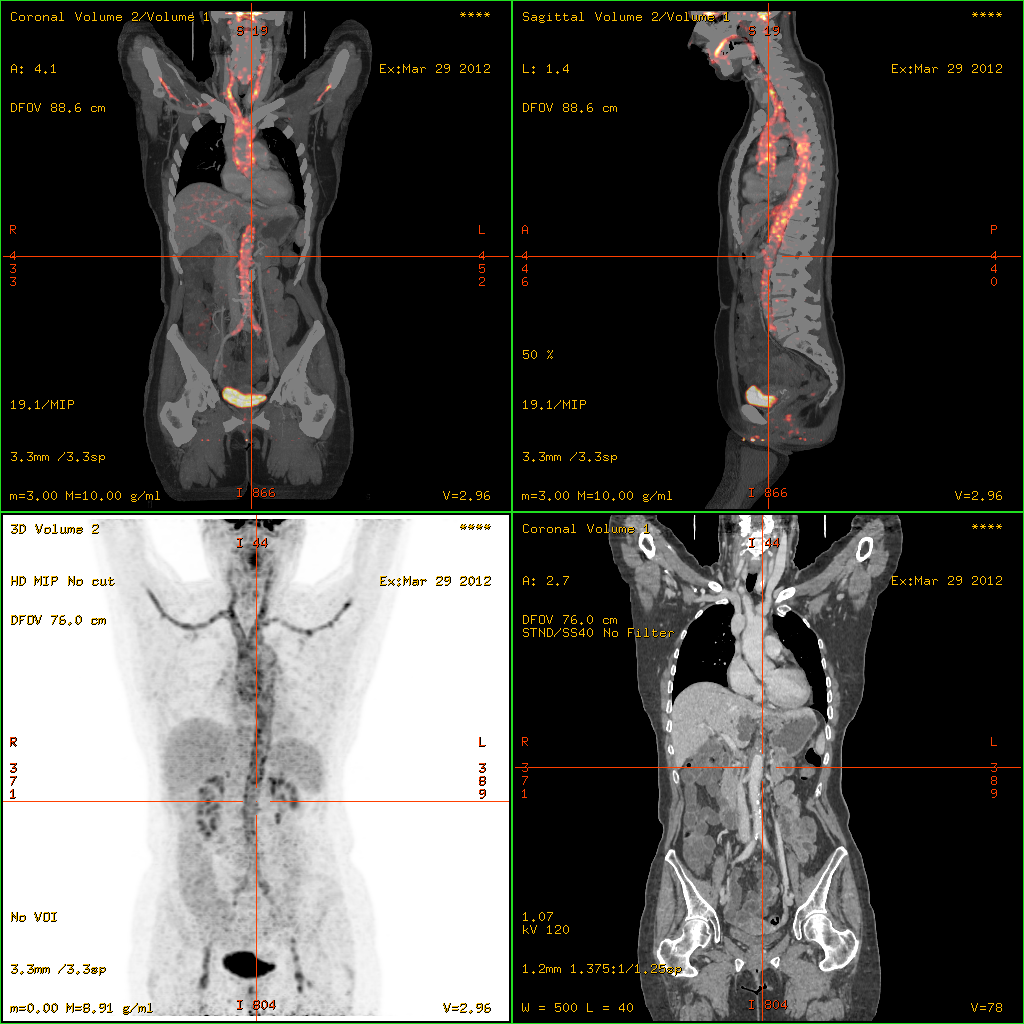|
Pigmentary Purpuric Eruptions
Pigmented purpuric dermatosis refers to one of the three major classes of skin conditions characterized by purpuric skin eruptions. Pigmented purpuric dermatosis are distinguished from other purpura by size (0.3–1 cm) and are most often seen in the lower extremities. Pigmentary purpuric eruptions may present with one of several clinical patterns. There may be overlapping characteristics among pigmented purpuric dermatosis and between their signs and those of other purpuric eruptions. Examples of the pigmented purpuric dermatosis group include: :* Schamberg's disease :* Majocchi's disease (Purpura annularis telangiectodes) :* Gougerot-Blum syndrome (Pigmented purpuric lichenoid dermatitis) :* Ducas and Kapetanakis pigmented purpura :* Lichen aureus Although vascular damage may be present, it is insufficient for these conditions to be considered forms of vasculitis. A few very small non-blinded studies of treatment with narrow-band ultraviolet light have been reported ... [...More Info...] [...Related Items...] OR: [Wikipedia] [Google] [Baidu] |
Schamberg Disease
Schamberg's disease, (also known as "progressive pigmentary dermatosis of Schamberg", "purpura pigmentosa progressiva" (PPP), and "Schamberg's purpura") is a chronic discoloration of the skin found in people of all ages, usually only affecting the feet, legs or thighs or a combination. It may occur as a single event or subsequent bouts may cause further spread. It is most common in males. It is named after Jay Frank Schamberg, who described it in 1901. There is no known cure for this disease but it is not a life-threatening condition and is mainly of cosmetic concern, although, because it can appear so suddenly, so extensively and because it usually leaves permanent discoloration of the skin, it can cause understandable psychological concern. The skin lesions sometimes cause itching, which can be treated by applying cortisone cream. The cortisone cream will only help with the itching and does not improve the discoloration of the skin. Schamberg's disease causes no other symptom ... [...More Info...] [...Related Items...] OR: [Wikipedia] [Google] [Baidu] |
Purpuric
Purpura () is a condition of red or purple discolored spots on the skin that do not blanch on applying pressure. The spots are caused by bleeding underneath the skin secondary to platelet disorders, vascular disorders, coagulation disorders, or other causes. They measure 3–10 mm, whereas petechiae measure less than 3 mm, and ecchymoses greater than 1 cm. Purpura is common with typhus and can be present with meningitis caused by meningococci or septicaemia. In particular, meningococcus (''Neisseria meningitidis''), a Gram-negative diplococcus organism, releases endotoxin when it lyses. Endotoxin activates the Hageman factor (clotting factor XII), which causes disseminated intravascular coagulation (DIC). The DIC is what appears as a rash on the affected individual. Classification Purpura are a common and nonspecific medical sign; however, the underlying mechanism commonly involves one of: * Platelet disorders (thrombocytopenic purpura) ** Primary thrombocyt ... [...More Info...] [...Related Items...] OR: [Wikipedia] [Google] [Baidu] |
Purpura
Purpura () is a condition of red or purple discolored spots on the skin that do not blanch on applying pressure. The spots are caused by bleeding underneath the skin secondary to platelet disorders, vascular disorders, coagulation disorders, or other causes. They measure 3–10 mm, whereas petechiae measure less than 3 mm, and ecchymoses greater than 1 cm. Purpura is common with typhus and can be present with meningitis caused by meningococci or septicaemia. In particular, meningococcus (''Neisseria meningitidis''), a Gram-negative diplococcus organism, releases endotoxin when it lyses. Endotoxin activates the Hageman factor (clotting factor XII), which causes disseminated intravascular coagulation (DIC). The DIC is what appears as a rash on the affected individual. Classification Purpura are a common and nonspecific medical sign; however, the underlying mechanism commonly involves one of: * Platelet disorders (thrombocytopenic purpura) ** Primary thromboc ... [...More Info...] [...Related Items...] OR: [Wikipedia] [Google] [Baidu] |
Schamberg's Disease
Schamberg's disease, (also known as "progressive pigmentary dermatosis of Schamberg", "purpura pigmentosa progressiva" (PPP), and "Schamberg's purpura") is a chronic discoloration of the skin found in people of all ages, usually only affecting the feet, legs or thighs or a combination. It may occur as a single event or subsequent bouts may cause further spread. It is most common in males. It is named after Jay Frank Schamberg, who described it in 1901. There is no known cure for this disease but it is not a life-threatening condition and is mainly of cosmetic concern, although, because it can appear so suddenly, so extensively and because it usually leaves permanent discoloration of the skin, it can cause understandable psychological concern. The skin lesions sometimes cause itching, which can be treated by applying cortisone cream. The cortisone cream will only help with the itching and does not improve the discoloration of the skin. Schamberg's disease causes no other symptom ... [...More Info...] [...Related Items...] OR: [Wikipedia] [Google] [Baidu] |
Majocchi's Disease
Majocchi's disease, also known as Purpura annularis telangiectodes of Majocchi is a not-well-recognized and uncommon skin condition characterized by purple/bluish-red 1- to 3-cm annular patches composed of dark red telangiectases with petechiae. It is one of a group of disorders referred to as pigmented purpuric dermatosis that all occur as a result of vascular inflammation and pigment deposition. Treatment Majocchi's disease is a chronic condition for which there is no cure. It often follows a recurrent course of alternating improvement and flares. There are treatments available to help improve the symptoms for some individuals, but responses vary. Some of these treatments include the application of topical steroids and ultraviolet therapy. The use of narrowband UVB and psoralen Psoralen (also called psoralene) is the parent compound in a family of naturally occurring organic compounds known as the linear furanocoumarins. It is structurally related to coumarin by the a ... [...More Info...] [...Related Items...] OR: [Wikipedia] [Google] [Baidu] |
Ducas And Kapetanakis Pigmented Purpura
Doucas and Kapetanakis pigmented purpura is a skin condition characterized by scaly and eczematous patches, which also have petechiae and hemosiderin Hemosiderin image of a kidney viewed under a microscope. The brown areas represent hemosiderin Hemosiderin or haemosiderin is an iron-storage complex that is composed of partially digested ferritin and lysosomes. The breakdown of heme gives rise ... staining. It is a lymphocytic capillaritis of unknown cause. Lesions consist of erythematous and purpuric macules which usually begin around the ankles, coalesce, and spread to involve the whole legs, and sometimes the trunk and upper extremities. The lesions are extremely pruritic (itchy) and occasionally lichenified after prolonged scratching. It is also known as "eczematoid purpura" or "eczematoid-like purpura". It was characterized in 1953. See also * Pigmentary purpuric eruptions * List of cutaneous conditions References External links Vascular-related cutaneous ... [...More Info...] [...Related Items...] OR: [Wikipedia] [Google] [Baidu] |
Lichen Aureus
Lichen aureus is a skin condition characterized by the sudden appearance of one or several golden or rust-colored, closely packed macule A skin condition, also known as cutaneous condition, is any medical condition that affects the integumentary system—the organ system that encloses the body and includes skin, nails, and related muscle and glands. The major function of this s ...s or lichenoid papules. See also * Pigmentary purpuric eruptions * List of cutaneous conditions References External links Vascular-related cutaneous conditions {{Cutaneous-condition-stub ... [...More Info...] [...Related Items...] OR: [Wikipedia] [Google] [Baidu] |
Vasculitis
Vasculitis is a group of disorders that destroy blood vessels by inflammation. Both arteries and veins are affected. Lymphangitis (inflammation of lymphatic vessels) is sometimes considered a type of vasculitis. Vasculitis is primarily caused by leukocyte migration and resultant damage. Although both occur in vasculitis, inflammation of veins (phlebitis) or arteries (arteritis) on their own are separate entities. Signs and symptoms Possible signs and symptoms include: * General symptoms: Fever, unintentional weight loss * Skin: Palpable purpura, livedo reticularis * Muscles and joints: Muscle pain or inflammation, joint pain or joint swelling * Nervous system: Mononeuritis multiplex, headache, stroke, tinnitus, reduced visual acuity, acute visual loss * Heart and arteries: Heart attack, high blood pressure, gangrene * Respiratory tract: Nosebleeds, bloody cough, lung infiltrates * GI tract: Abdominal pain, bloody stool, perforations (hole in the GI tract) * Kidneys: Inflamma ... [...More Info...] [...Related Items...] OR: [Wikipedia] [Google] [Baidu] |
Purpura
Purpura () is a condition of red or purple discolored spots on the skin that do not blanch on applying pressure. The spots are caused by bleeding underneath the skin secondary to platelet disorders, vascular disorders, coagulation disorders, or other causes. They measure 3–10 mm, whereas petechiae measure less than 3 mm, and ecchymoses greater than 1 cm. Purpura is common with typhus and can be present with meningitis caused by meningococci or septicaemia. In particular, meningococcus (''Neisseria meningitidis''), a Gram-negative diplococcus organism, releases endotoxin when it lyses. Endotoxin activates the Hageman factor (clotting factor XII), which causes disseminated intravascular coagulation (DIC). The DIC is what appears as a rash on the affected individual. Classification Purpura are a common and nonspecific medical sign; however, the underlying mechanism commonly involves one of: * Platelet disorders (thrombocytopenic purpura) ** Primary thromboc ... [...More Info...] [...Related Items...] OR: [Wikipedia] [Google] [Baidu] |
Skin Lesion
A skin condition, also known as cutaneous condition, is any medical condition that affects the integumentary system—the organ system that encloses the body and includes skin, nails, and related muscle and glands. The major function of this system is as a barrier against the external environment. Conditions of the human integumentary system constitute a broad spectrum of diseases, also known as dermatoses, as well as many nonpathologic states (like, in certain circumstances, melanonychia and racquet nails). While only a small number of skin diseases account for most visits to the physician, thousands of skin conditions have been described. Classification of these conditions often presents many nosological challenges, since underlying causes and pathogenetics are often not known. Therefore, most current textbooks present a classification based on location (for example, conditions of the mucous membrane), morphology ( chronic blistering conditions), cause (skin conditions resul ... [...More Info...] [...Related Items...] OR: [Wikipedia] [Google] [Baidu] |
List Of Cutaneous Conditions
Many skin conditions affect the human integumentary system—the organ system covering the entire surface of the body and composed of skin, hair, nails, and related muscle and glands. The major function of this system is as a barrier against the external environment. The skin weighs an average of four kilograms, covers an area of two square metres, and is made of three distinct layers: the epidermis, dermis, and subcutaneous tissue. The two main types of human skin are: glabrous skin, the hairless skin on the palms and soles (also referred to as the "palmoplantar" surfaces), and hair-bearing skin.Burns, Tony; ''et al''. (2006) ''Rook's Textbook of Dermatology CD-ROM''. Wiley-Blackwell. . Within the latter type, the hairs occur in structures called pilosebaceous units, each with hair follicle, sebaceous gland, and associated arrector pili muscle. In the embryo, the epidermis, hair, and glands form from the ectoderm, which is chemically influenced by the underlying mesoderm th ... [...More Info...] [...Related Items...] OR: [Wikipedia] [Google] [Baidu] |


